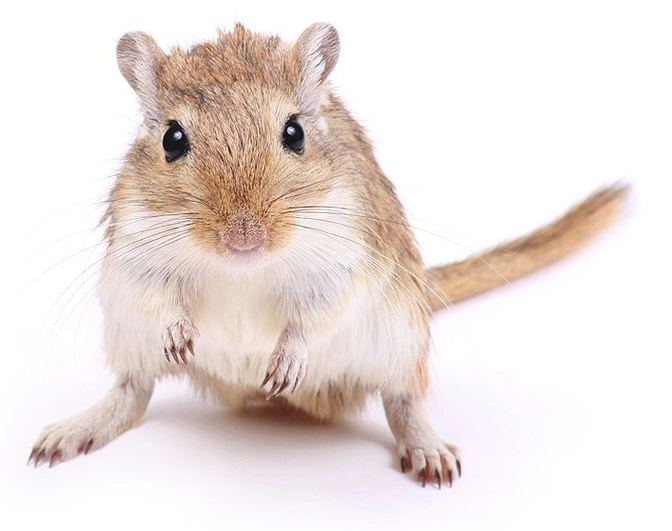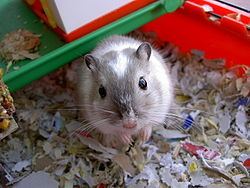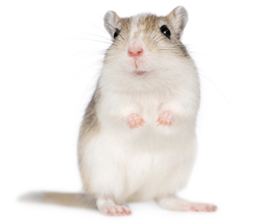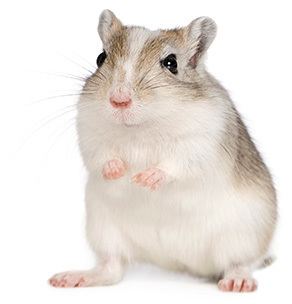Kingdom Animalia Order Rodentia Subfamily Gerbillinae
Gray, 1825 Mass Pachyuromys duprasi: 40 g | Phylum Chordata Family Muridae Scientific name Gerbillinae Tail length Pachyuromys duprasi: 5 cm | |
 | ||
Gestation period Pachyuromys duprasi: 19 days Lifespan Pachyuromys duprasi: 5 – 8 years, Great gerbil: 2 – 4 years Length Pachyuromys duprasi: 10 cm, Great gerbil: 15 – 20 cm Lower classifications Mongolian gerbil, Meriones, Gerbillus, Psammomys, Great gerbil | ||
Pet rodents how to train a gerbil
A gerbil is a small mammal of the order Rodentia. Once known simply as "desert rats", the gerbil subfamily includes about 110 species of African, Indian, and Asian rodents, including sand rats and jirds, all of which are adapted to arid habitats. Most are primarily diurnal (though some, including the common household pet, do exhibit crepuscular behavior), and almost all are omnivorous.
Contents
- Pet rodents how to train a gerbil
- Pet rodents buying gerbils
- Behavior
- As pets
- Housing in captivity
- Mating
- Reasons for popularity
- Teeth problems
- Trauma
- Neglect
- Epilepsy
- Tumors
- Tail sloughing
- Tyzzers disease
- Deafness and inner ear problems
- Captive bred gerbils
- Classification
- References

The word "gerbil" is a diminutive form of "jerboa", though the jerboas are an unrelated group of rodents occupying a similar ecological niche.

One Mongolian species, Meriones unguiculatus, also known as the clawed jird, is a gentle and hardy animal that has become a popular pet. It was first brought from China to Paris, France, in the 19th century, and became a popular house pet. It was then brought to the United States in 1954 by Dr. Victor Schwentker for use in research.

Gerbils are typically between six and twelve inches (150 and 300 mm) long, including the tail, which makes up about one-half of their total length. One species, the great gerbil, or Rhombomys opimus, originally native to Turkmenistan, can grow to more than 16 inches (410 mm). The average adult gerbil weighs about 2.5 ounces (71 g).

Pet rodents buying gerbils
Behavior
Gerbils are social animals, and live in groups in the wild. They rely on their sense of smell to identify other members of their clan, so it is important to use what is commonly referred to as the "split tank method" when introducing gerbils from separate litters. Gerbils are known to attack and often kill those carrying an unfamiliar scent.
As pets
Gerbils were first introduced to the pet industry in 1964. These were the Mongolian gerbils. Their value as pets was soon appreciated and they are now found in pet shops all over the UK and USA. Due to the threat they pose to indigenous ecosystems and existing agricultural operations, it is illegal to purchase, import, or keep a gerbil as a pet in the US state of California.
Housing in captivity
A common misunderstanding when purchasing a home for pet gerbils is they can live in housing designed for hamsters and mice. This is not correct, as they need to be able to dig tunnel systems, rather than have them created for them. The commonly plastic structure of hamster and mouse cages is inappropriate for gerbils due to their ability to gnaw through it very quickly. Plastic can cause serious health issues for the animal if ingested, therefore many owners refrain from having any plastic in the tank and rely entirely on wooden toys. Information from gerbil societies from throughout the globe is conflicting with regards to tank sizing. However, a common minimum given appears to be 10 imperial gallons (45 l) per gerbil.
Mating
Gerbils will mate for several hours, in frequent short bursts followed by short chases, when the female allows the male to catch her. Once he catches her, the female will squeak and make flick motions to get the male off her. Males will not attack females except in rare circumstances, which may also include them having been separated from their original mates, or widowed. A female may attack a male, but usually he is more than a match for her.
Reasons for popularity
The several reasons for the popularity of gerbils as household pets include: The animals are typically not aggressive, and they rarely bite unprovoked or without stress. They are small and easy to handle, since they are sociable creatures that enjoy the company of humans and other gerbils. Gerbils also have adapted their kidneys to produce a minimum of waste to conserve body fluids, which makes them very clean with little odor.
Teeth problems
Misalignment of incisors due to injury or malnutrition may result in overgrowth, which can cause injury to the roof of the mouth. Symptoms include a dropped or loss of appetite, drooling, weight loss, or foul breath. The teeth must be clipped by a veterinarian regularly for as long as required.
Trauma
Common injuries are caused by gerbils being dropped or falling, often while inside of a hamster ball, which can cause broken limbs or a fractured spine (for which there is no cure).
Neglect
A common problem for all small rodents is neglect, which can cause the gerbils to not receive adequate food and water, causing serious health concerns, including dehydration, starvation, stomach ulcers, eating of bedding material, and cannibalism.
Epilepsy
Between 20 and 50% of all pet gerbils have the seizure disorder epilepsy. The seizures are thought to be caused by fright, handling, or a new environment. The attacks can be mild to severe, but do not typically appear to have any long-term effects, except for rare cases where death results from very severe seizures. A way to prevent a gerbil from having a seizure is to refrain from blowing in the animal's face (often used to "train" the pet not to bite). This technique is used in a lab environment to induce seizures for medical research.
Tumors
Tumors, both benign and malignant, are fairly common in pet gerbils, and are most common in females over the age of two. Usually, the tumors involve the ovaries, causing an extended abdomen, or the skin, with tumors most often developing around the ears, feet, midabdomen, and base of the tail, appearing as a lump or abscess. The scent gland (positioned on the abdomen) should be checked regularly; a veterinarian can operate on the lump where possible.
Tail sloughing
Gerbils can lose their tails due to improper handling, being attacked by another animal, or getting their tails stuck. The first sign is a loss of fur from the tip of the tail, then, the skinless tail dies off and sloughs, with the stump usually healing without complications.
Tyzzer's disease
The most common infectious disease in gerbils is Tyzzer's disease, a bacterial disease, which stress can make animals more susceptible to. It produces symptoms such as ruffled fur, lethargy, hunched posture, poor appetite, diarrhoea, and often death. It quickly spreads between gerbils in close contact.
Deafness and inner ear problems
A problem with the inner ear can be spotted by a gerbil leaning to one side quite obviously. The fluids in the ears affect balance. However, this does not appear to affect the gerbils too much, which have an aptitude of just getting on with things, and getting used to their conditions. Gerbils with "extreme white spotting" colouring are susceptible to deafness; this is thought to be due to the lack of pigmentation in and around the ear.
Captive-bred gerbils
Many color varieties of gerbils are available in pet shops today, generally the result of years of selective breeding.
Over 20 different coat colors occur in the Mongolian gerbil, which has been captive-bred the longest.
Another species of gerbil has also been recently introduced to the pet industry: the fat-tailed gerbil, or duprasi. They are smaller than the common Mongolian gerbils, and have long, soft coats and short, fat tails, appearing more like a hamster. The variation on the normal duprasi coat is more gray in color, which may be a mutation, or it may be the result of hybrids between the Egyptian and Algerian subspecies of duprasi.
White spotting has been reported in not only the Mongolian gerbil, but also the pallid gerbil and possibly Sundervall's Jird.
A long-haired mutation, a grey agouti or chinchilla mutation, white spotting, and possibly a dilute mutation have also appeared in Shaw's jirds, and white spotting and a dilute mutation have shown up in Bushy-tailed Jirds.
Classification
SUBFAMILY GERBILLINAE
